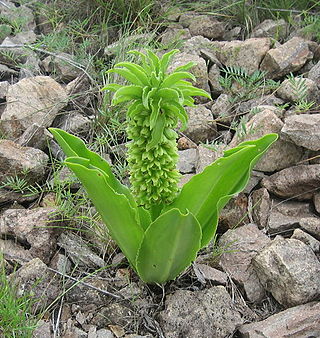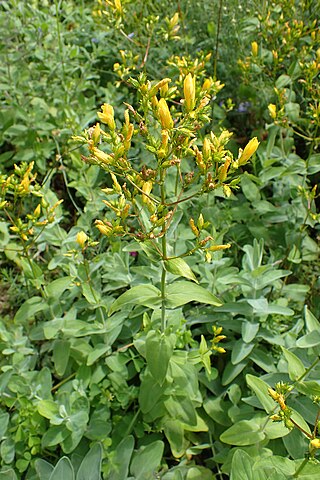
Amorphophallus is a large genus of some 200 tropical and subtropical tuberous herbaceous plants from the Arum family (Araceae), native to Asia, Africa, Australia and various oceanic islands. A few species are edible as "famine foods" after careful preparation to remove irritating chemicals. The genus includes the Titan arum of Indonesia, which has the largest inflorescence of any plant in the genus, and is also known as the 'corpse flower' for the pungent odour it produces during its flowering period, which can take up through seven years of growth before it occurs.

An inflorescence, in a flowering plant, is a group or cluster of flowers arranged on a stem that is composed of a main branch or a system of branches. An inflorescence is categorized on the basis of the arrangement of flowers on a main axis (peduncle) and by the timing of its flowering.

Chlorophytum comosum, usually called spider plant or common spider plant due to its spider-like look, also known as spider ivy, airplane plant, ribbon plant, and hen and chickens, is a species of evergreen perennial flowering plant of the family Asparagaceae. It is native to tropical and Southern Africa but has become naturalized in other parts of the world, including Western Australia and Bangladesh. Chlorophytum comosum is easy to grow as a houseplant because of its resilience, but it can be sensitive to the fluoride in tap water, which commonly gives it "burnt tips". Variegated forms are the most popular.

Commelinaceae is a family of flowering plants. In less formal contexts, the group is referred to as the dayflower family or spiderwort family. It is one of five families in the order Commelinales and by far the largest of these with about 731 known species in 41 genera. Well known genera include Commelina (dayflowers) and Tradescantia (spiderworts). The family is diverse in both the Old World tropics and the New World tropics, with some genera present in both. The variation in morphology, especially that of the flower and inflorescence, is considered to be exceptionally high amongst the angiosperms.

Chamaerops is a genus of flowering plants in the family Arecaceae. It contains only one species, Chamaerops humilis, variously called European fan palm or the Mediterranean dwarf palm. It is one of the most cold-hardy palms and is used in landscaping in temperate climates.

Borassus is a genus of five species of fan palms, native to tropical regions of Africa, Asia, and Papua New Guinea.

Leptotes, abbreviated Lpt in horticultural trade, is a genus of orchids formed by nine small species that grow in the dry jungles of south and southeast Brazil, and also in Paraguay or Argentina. They are small epiphytic plants of caespitose growth that sometimes resemble little Brassavola, as they share the same type of thin terete leaves, though they are more closely related to Loefgrenianthus.

Arum is a genus of flowering plants in the family Araceae, native to Europe, northern Africa, and western and central Asia, with the highest species diversity in the Mediterranean region. Frequently called arum lilies, they are not closely related to the true lilies Lilium. Plants in closely related Zantedeschia are also called "arum lilies".

The Proteaceae form a family of flowering plants predominantly distributed in the Southern Hemisphere. The family comprises 83 genera with about 1,660 known species. Australia and South Africa have the greatest concentrations of diversity. Together with the Platanaceae, Nelumbonaceae and in the recent APG IV system the Sabiaceae, they make up the order Proteales. Well-known Proteaceae genera include Protea, Banksia, Embothrium, Grevillea, Hakea, and Macadamia. Species such as the New South Wales waratah, king protea, and various species of Banksia, Grevillea, and Leucadendron are popular cut flowers. The nuts of Macadamia integrifolia are widely grown commercially and consumed, as are those of Gevuina avellana on a smaller scale.

Drosera cuneifolia is a small rosette-forming species of perennial sundew native to the Cape in South Africa. It was first described in 1781.

Eucomis autumnalis, the autumn pineapple flower, or autumn pineapple lily, is a species of flowering plant in the family Asparagaceae, subfamily Scilloideae, native to Malawi, Zimbabwe and southern Africa. It is a mid to late summer flowering deciduous bulbous perennial. The flower stem reaches about 40 cm (16 in), rising from a basal rosette of wavy-edged leaves. The green, yellow or white flowers are arranged in a spike (raceme), topped by a "head" of green leaflike bracts. It is grown as an ornamental garden plant and can also be used as a cut flower.
Tridactyle is a genus of flowering plants from the orchid family, Orchidaceae. It has about 60-70 known species, all native to sub-Saharan Africa.

Watsonia marginata is a species of flowering plant in the family Iridaceae known by the common name fragrant bugle-lily. It is native to the Cape Provinces of South Africa, but it is well known as an ornamental plant grown in gardens for its showy spikes of flowers. Its native range is an area with winter rainfall and dry summers. It is a perennial herb growing from a corm and growing to a maximum height well over one metre when in flower, sometimes reaching two metres. Each corm produces three or four erect leaves that measure up to 80 cm long by 5 wide. They are blue-green with thickened yellow margins. The inflorescence is a dense spike of 30 to 50 flowers which may be any shade of pink or sometimes dark red or white. The flower is actinomorphic, or radially symmetrical, unlike those of other Watsonia, which are zygomorphic. The flowers are several cm long.

Watsonia meriana is a species of flowering plant in the family Iridaceae known by the common name bulbil bugle-lily. It is one of several Watsonia species known as wild watsonia. It is native to the Cape Provinces of South Africa, but it is well known as an ornamental plant grown in gardens for its showy spikes of flowers, and is an invasive species in areas where it has escaped cultivation.

Gasteria brachyphylla, the Klein Karoo gasteria, is succulent plant native to the Western Cape, South Africa.

Hypericum annulatum is a species of flowering plant in the family Hypericaceae. It is a perennial herb of varying heights which grows upright, with more than a hundred flowers of a golden yellow color. First described in 1827, the species has a wide distribution from Eastern Europe to East Africa, and its appearance can vary greatly based on its geographic location. It has been used in Bulgarian folk medicine, and has more recently been investigated for its effectiveness in slowing the growth of or killing certain types of human cancer.

Hypericum undulatum, the wavy St Johns Wort, is a herbaceous perennial flowering plant native to western Europe and northern Africa. The specific name undulatum is Latin, meaning "wavy" or "undulated", referring, just as the common name, to the wavy leaf margins of the herb. The plant has a diploid number of 16 or 32.

Mimetes palustris or cryptic pagoda is an evergreen shrub, assigned to the family Proteaceae. It has horizontal sprawling shoots as well as upright, unbranched shoots usually about ½ m (1½ in) high. The leaves are entire and stand out on the lower parts of the shoots, but are overlapping and pressed tightly against each other near the inflorescence, almost like a snakeskin. The inflorescence consists of several flowerheads, each containing three clear yellow flowers that are longer than the subtending leaves. It is the smallest species of Mimetes and is an endemic species that grows on well-drained, but permanently moist sandy and peaty slopes in the mountains near Hermanus, Western Cape province of South Africa. It is considered critically endangered. Flowering occurs all year round, but peaks in August and September.

Protea nana, also known as the mountain rose or mountain-rose sugarbush, is a flowering shrub which belongs within the genus Protea.

Wachendorfia thyrsiflora, the marsh butterfly lily, is a plant species of 0.6–2.5 m (2.0–8.2 ft) high when flowering, that has been assigned to the bloodroot family. It is a large to very large evergreen perennial plant with an underground rootstock with clusters of roots produced at the nodes. The rootstock has a distinctive red colour that results from so-called arylphenalenone pigments. The sturdy, entire and broadly sword-shaped leaves have laterally flattened and pleated leaf blades. The golden yellow flowers are set a dense cylindrical panicle on a tall firm stalk. Flowering occurs from spring until mid-summer.



















